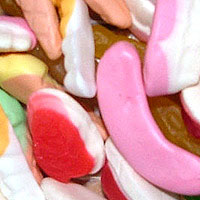 Is your house full of lolly bags?
Is your house full of lolly bags?
Strangely, we seemed to have a long weekend filled with all four of my children attending at least two birthday parties each, and every time returning with an ENORMOUS lolly bag. These few party days were then followed up with Halloween festivities—increasingly popular now, even here in Australia.
As most of you are aware, children traditionally dress up in scary Halloween costumes, bellow “trick or treat” throughout the neighbourhood and in return they are joyfully given a handful of lollies at each doorstep. By the time you have wandered a number of streets a child’s treat bag is typically bursting with frightening coloured lolly spiders, snakes, gumballs and marshmallow eyeballs.
Judging by the colours of most of these lollies and the effects colourings has on children’s behaviour—my hunch was that the events to follow consumption would be scarier than any child’s Halloween costume!!!
I have an agreement with my boys that they ask before eating any junk food and I always thank them for remembering to ask before consuming. Together we then decide if that is an appropriate option given the time of day, other menu items, etc, and I remind them that it is important to consider what we are putting into our bodies rather than mindlessly gobbling away on junk.
Knowing they had already had a few days of parties, I conceded to the boys picking one lolly while we wandered the streets but had to think quickly upon our return home as to what to do with our increasing volume of ‘nightmare treats’.
I asked the boys to gather all of their lolly bags and spread out the contents in front of them onto the table. I then asked them all to come up with some solutions for the ‘right pickle’ we found ourselves in. I was sure to exaggerate my look of horror at all of the hideous colours and remind them about the dangers and health effects of food colourings—highlighting the effects of yellow, blue and red colourings (please see below)—facts that my boys are very familiar with but it never hurts to remind them in desperate times.
Of course, if we do not allow our children to have junk foods occasionally, then they elate any illusion they have with these foods and inevitably sneak them behind our backs. So somehow we have to strike a balance in letting our children try these foods at the same time as empowering them with knowledge about how these foods impact their growing minds and bodies.
Now some of you may be thinking this is a harsh and unkind approach, you may say, “Just let them be kids”. Let us not forget however that most foods our children eat today are full of cheap dangerous chemicals. Additives that when mixed together (through food combining) have never been studied as to their health effects. Remembering also that times have changed and what are considered pure foods today such as fruits and vegetables, are often extremely high in pesticides and low in vitamins and minerals, resulting in most children having a diet that is nutrient-lacking and highly deficient.
My suggestion to the boys was that they pick out the lollies they really didn’t want to part with and those they were happy to throw out in exchange for higher quality chocolate. While chocolate certainly still has lots of sugar and sometimes unnatural chemicals, good quality chocolate has far less additives then the chemical concoctions that lay before us.
On this occasion I offered that the larger the number of lollies they parted with, larger the portion of chocolate I would return in exchange. They all seemed delighted with this solution and surprising found it relatively easy to select only a few lollies that they really wanted to keep and try. From a young age we have helped our boys appreciate dark chocolate so I was even able to mix dark and milk chocolate into the exchange. Toblerones at this age win hands down though!!
Other ideas we use successfully include offering to exchange junk lollies for something else they value:
- Lollies that do not have colours and additives, e.g. Natural Confectionary Company—God bless them!!
- A new book, or toy, or money (one of our boys is a real ‘saver’)
…Whatever works for your family.
We also make sure that if the boys are going to eat lollies on a weekend for example, they can have a couple of lollies then they have to have a glass of water and go outside for a period of time. This way we are not the victims of their hyperactivity!
Hopefully these are some useful ideas for any parent distressed by lolly bags!!
One last thought…
Here are some of the health effects I remind the boys about periodically. You can find these in most additive books—it is a great idea to keep one in your handbag when shopping.
- Tartrazine (102) – yellow colouring has potential health effects including aggressive behaviour, headache, insomnia, hay fever, asthma and hyperactivity. Tartrazine is banned in many countries but unfortunately not here in Australia.
- Brilliant Blue (133) – has an aluminium base.
- Annatto (160b) – red colouring has been known to cause itching and behaviour changes.
Wishing you health and happiness,
Jennifer Barham-Floreani
Bach. Chiropractic, Bach. App Clinical Science
Registered internationally, no longer practicing as a chiropractor in Australia.
. . .
Salmon J. Pearce L. Autism & Attention Deficit Disorders. Bangor; Persimmon Press: 2006.
Walker Smith JA. Diagnostic Criteria for Gastrointestinal Food Allergy in Childhood. Clin Exp Allergy. 1995;25:20-22.


 Is your house full of lolly bags?
Is your house full of lolly bags?
